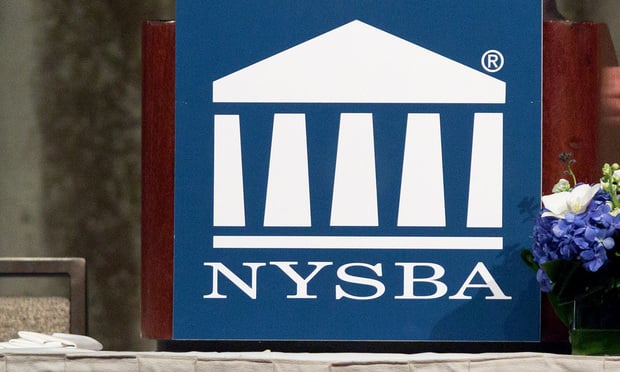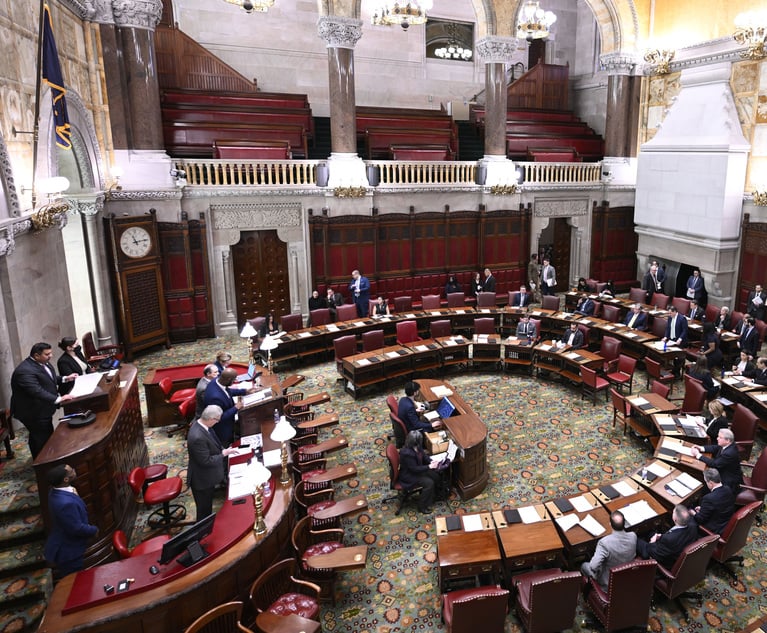Greenberg Stresses NY State Bar's Support of Court Consolidation Plan
Each of the state's trial courts has a separate purpose, often making it difficult for litigants to navigate, especially when a case falls under the jurisdiction of multiple tribunals.
January 24, 2020 at 05:33 PM
5 minute read
 Photo: Carmen Natale/ALM
Photo: Carmen Natale/ALM
The president of the New York State Bar Association has thrown his full support behind a campaign by Chief Judge Janet DiFiore and Gov. Andrew Cuomo to consolidate New York's byzantine trial court system into a streamlined model that he said would simplify litigation and boost court efficiency.
In interviews with the New York Law Journal, NYSBA president Hank Greenberg, a shareholder at Greenberg Traurig, decried the state's current structure of 11 separate trial courts as the result of "historical accumulation" and "not rational design."
"No one in their right mind would design a system like this," he said.
The state bar, he said, would stand "100% behind" the modernization efforts, which are expected to work their way through the state Legislature in the coming weeks.
Greenberg spoke to the Law Journal this week on the eve of the NYSBA's annual meeting Jan. 27 to Jan. 31 in Midtown. His comments also came after Cuomo, a Democrat serving his third term as governor, earlier this month endorsed DiFiore's ambitious new plan to create a three-tiered system that would fold many of the state's trial courts into one unified entity.
Cuomo included a similar proposal in his executive budget for the 2021 fiscal year, which the governor announced Tuesday in his yearly budget address.
In a statement Wednesday, Greenberg applauded Cuomo's commitment to modernizing the court system and offered any assistance the state bar could provide in making it happen.
"The present system, with its 11 trial courts, is confusing for litigants, costly for taxpayers and makes case management difficult. We are grateful to the governor and Chief Judge Janet DiFiore for their support, and our association stands ready to help in any way we can to make this proposal a reality."
Currently, New York has 11 separate trial courts, ranging from state Supreme Court to City Court. The state Supreme Court is the trial court of general jurisdiction, under the Appellate Division and the Court of Appeals, the state's highest court.
Each of the state's trial courts has a separate purpose, often making it difficult for litigants to navigate, especially when a case falls under the jurisdiction of multiple tribunals.
DiFiore's plan, unveiled in September, would consolidate those courts into a simplified structure consisting of centralized state Supreme Court, a Municipal Court and the current town and village courts. The first meaningful update to the state's court system in over 100 years, her vision eliminates the state Court of Claims, County Courts, Family Courts and Surrogate's Courts, but the judges on the courts would remain and become state Supreme Court justices.
The newly consolidated state Supreme Court would have six divisions: family, probate, criminal, state claims, commercial and general.
The proposal would eliminate a cap on the number of state Supreme Court judgeships that was enshrined in the state constitution more than a century ago, and it would allow the Legislature to add more judicial positions, if necessary. Lawmakers would also be authorized to review, every 10 years, whether the number of Appellate Division Departments should be modified to accommodate the state's justice system. New York currently has four state appellate courts, but some have pushed for at least one more.
The changes would require an amendment to the state constitution, which requires lawmakers to vote in two separate sessions of the Legislature, followed by a referendum, which would put the issue directly to voters. If the Legislature approves the first leg during the 2020 session, the changes could be placed on the ballot as early as 2021.
Lawmakers, however, have shown little appetite for the reforms, which have been floated in one way or another for decades.
Many past proposals have called for appointed judges, but DiFiore's approach would employ a "merger-in-place" strategy that would not alter the length of judicial terms or the way judges are selected.
Still, skeptics of DiFiore's reforms have raised questions about how they might impact diversity on the bench, and the Association of Justices of the Supreme Court of New York State has flatly rejected the plan as giving the Office of Court Administration too much power to shift judges outside their jurisdictions or areas of expertise.
Justice Lawrence Marks, the state's chief administrative judge, argued in November that those concerns were unfounded, saying it was "almost a truism that our proposal will lead to more diversity on the [state] Supreme Court bench in upstate jurisdictions," where the share of judgeships held by persons of color would be folded into the state Supreme Court.
Greenberg, in interviews, also threw cold water on claims of potential abuse by the OCA. Greenberg said those arguments ignored the creation of various divisions within the Supreme Court and assumed that the OCA would act out of its own interest in assigning judges to cases in areas where they lacked experience.
"The court system isn't there for the convenience of judges," he said. "It's there for the public, and simplifying the court system will serve the public."
Read More:
NY Lawmakers Eye DiFiore's Court Reform Plan for Impact on Judicial Diversity
DiFiore's Trial Court Restructuring Plan Draws Opposition From Justices' Group
DiFiore Unveils Detailed Proposal for Lawmakers to Overhaul New York's Trial Courts
This content has been archived. It is available through our partners, LexisNexis® and Bloomberg Law.
To view this content, please continue to their sites.
Not a Lexis Subscriber?
Subscribe Now
Not a Bloomberg Law Subscriber?
Subscribe Now
NOT FOR REPRINT
© 2025 ALM Global, LLC, All Rights Reserved. Request academic re-use from www.copyright.com. All other uses, submit a request to [email protected]. For more information visit Asset & Logo Licensing.
You Might Like
View All

Federal Judge Pauses Trump Funding Freeze as Democratic AGs Plan Suit
4 minute read
Relaxing Penalties on Discovery Noncompliance Allows Criminal Cases to Get Decided on Merit
5 minute read
Bipartisan Lawmakers to Hochul Urge Greater Student Loan Forgiveness for Public-Interest Lawyers
Trending Stories
- 1Morris Nichols Partners to Be Involved With PLI Program
- 2How I Made Practice Group Chair: 'Cultivating a Culture of Mutual Trust Is Essential,' Says Gina Piazza of Tarter Krinsky & Drogin
- 3People in the News—Feb. 3, 2025—Antheil Maslow, Kang Haggerty, Saxton & Stump
- 4Patent Pending ... and Pending ... and Pending? Brace Yourself for Longer Waits
- 5Indian Law Firm Cyril Amarchand Rolls Out AI Strategy, Adopts Suite of AI Tools
Who Got The Work
J. Brugh Lower of Gibbons has entered an appearance for industrial equipment supplier Devco Corporation in a pending trademark infringement lawsuit. The suit, accusing the defendant of selling knock-off Graco products, was filed Dec. 18 in New Jersey District Court by Rivkin Radler on behalf of Graco Inc. and Graco Minnesota. The case, assigned to U.S. District Judge Zahid N. Quraishi, is 3:24-cv-11294, Graco Inc. et al v. Devco Corporation.
Who Got The Work
Rebecca Maller-Stein and Kent A. Yalowitz of Arnold & Porter Kaye Scholer have entered their appearances for Hanaco Venture Capital and its executives, Lior Prosor and David Frankel, in a pending securities lawsuit. The action, filed on Dec. 24 in New York Southern District Court by Zell, Aron & Co. on behalf of Goldeneye Advisors, accuses the defendants of negligently and fraudulently managing the plaintiff's $1 million investment. The case, assigned to U.S. District Judge Vernon S. Broderick, is 1:24-cv-09918, Goldeneye Advisors, LLC v. Hanaco Venture Capital, Ltd. et al.
Who Got The Work
Attorneys from A&O Shearman has stepped in as defense counsel for Toronto-Dominion Bank and other defendants in a pending securities class action. The suit, filed Dec. 11 in New York Southern District Court by Bleichmar Fonti & Auld, accuses the defendants of concealing the bank's 'pervasive' deficiencies in regards to its compliance with the Bank Secrecy Act and the quality of its anti-money laundering controls. The case, assigned to U.S. District Judge Arun Subramanian, is 1:24-cv-09445, Gonzalez v. The Toronto-Dominion Bank et al.
Who Got The Work
Crown Castle International, a Pennsylvania company providing shared communications infrastructure, has turned to Luke D. Wolf of Gordon Rees Scully Mansukhani to fend off a pending breach-of-contract lawsuit. The court action, filed Nov. 25 in Michigan Eastern District Court by Hooper Hathaway PC on behalf of The Town Residences LLC, accuses Crown Castle of failing to transfer approximately $30,000 in utility payments from T-Mobile in breach of a roof-top lease and assignment agreement. The case, assigned to U.S. District Judge Susan K. Declercq, is 2:24-cv-13131, The Town Residences LLC v. T-Mobile US, Inc. et al.
Who Got The Work
Wilfred P. Coronato and Daniel M. Schwartz of McCarter & English have stepped in as defense counsel to Electrolux Home Products Inc. in a pending product liability lawsuit. The court action, filed Nov. 26 in New York Eastern District Court by Poulos Lopiccolo PC and Nagel Rice LLP on behalf of David Stern, alleges that the defendant's refrigerators’ drawers and shelving repeatedly break and fall apart within months after purchase. The case, assigned to U.S. District Judge Joan M. Azrack, is 2:24-cv-08204, Stern v. Electrolux Home Products, Inc.
Featured Firms
Law Offices of Gary Martin Hays & Associates, P.C.
(470) 294-1674
Law Offices of Mark E. Salomone
(857) 444-6468
Smith & Hassler
(713) 739-1250






